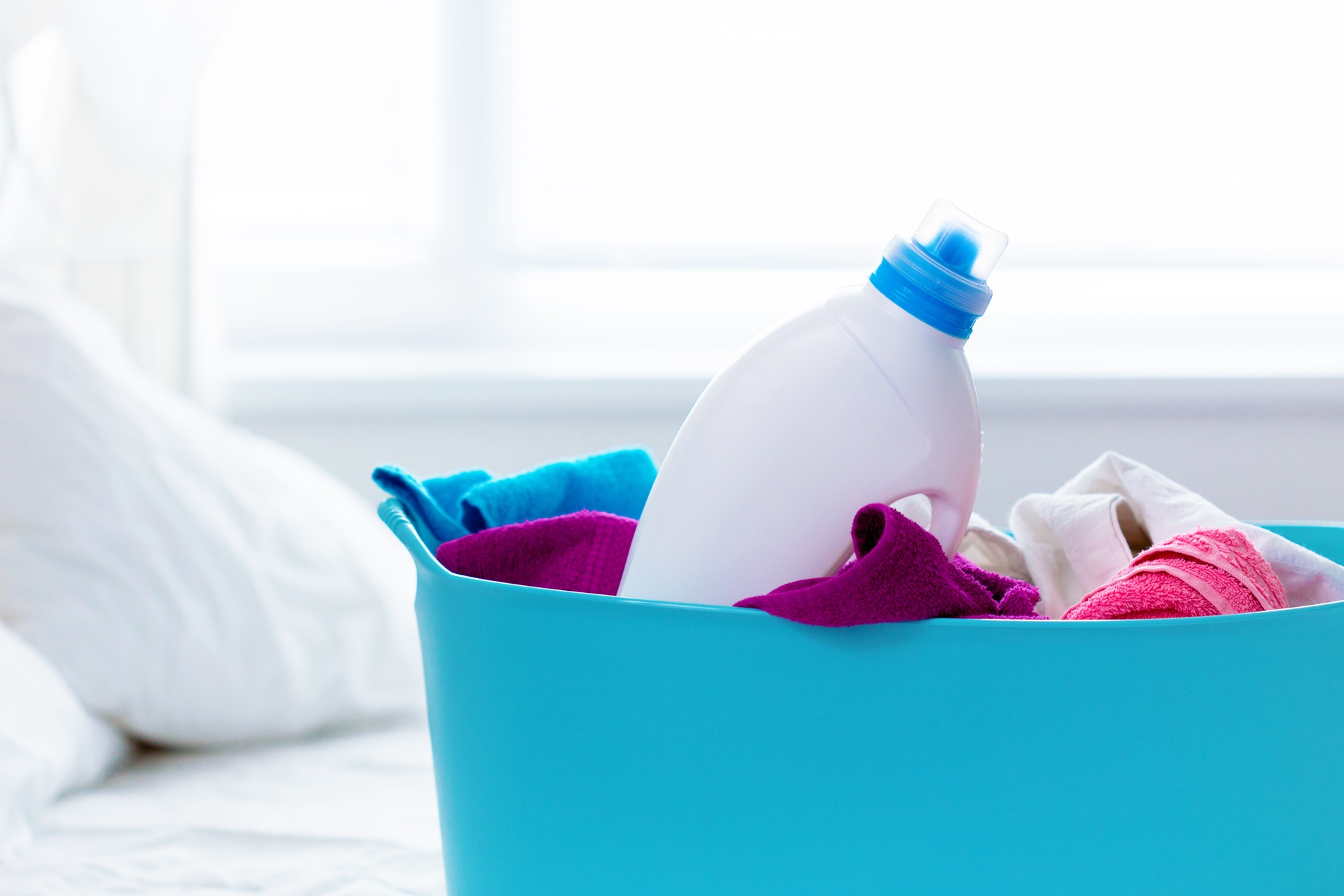Fabric softener is great for keeping clothes soft, reducing static, and adding a fresh scent. No wonder it’s a laundry staple in many households. But when using it on colored clothes, is it really the best choice? While the benefits are apparent, others caution it may lead to fading, residue buildup, and weakened fabric fibers over time.
If you ever notice your favorite dark jeans looking dull or your bright shirts losing their vibrancy, your fabric softener might be part of the problem. But is it something you should stop using altogether, or is there a better way to protect your clothes while still enjoying the softness?
In this guide, we break down how fabric softener affects colored fabrics, when it’s safe to use, and the best alternatives to keep your clothes looking fresh and bright. Let’s get into it!
What Fabric Softener Does to Colored Clothes
Fabric softener works by coating fabric fibers with a thin layer of lubricating chemicals, making them feel smooth and less prone to static. However, this coating comes with some downsides for colored clothes:
1. It Creates a Residue That Dulls Color
The softening agents build up on fabric over time, trapping detergent, dust, and dirt. This coating makes colored clothes look faded or muted rather than crisp and vibrant.
2. It Interferes with Dye Stability
Some fabric softeners contain optical brighteners that alter the way color appears, making fabrics look less rich over time. Chemical interactions between softeners and textile dyes can weaken dye bonds, leading to gradual fading.
3. It Prevents Fabrics from Properly Absorbing Water
Since softener coats each fiber, it makes the material less absorbent. This can cause problems for towels, activewear, and certain cotton fabrics, making them feel less breathable and less effective at moisture absorption.
How Fabric Softener Affects Different Fabrics
Fabric softener is often used to make clothes feel soft, reduce wrinkles, and eliminate static, but it doesn’t work the same way on every type of fabric. If you’re unsure whether fabric softener is safe for your favorite clothes, this guide breaks down how different fabrics react and whether you should use softener, an alternative, or skip it entirely.
Fabrics That Can Handle Fabric Softener (With Caution)
Some textiles are more resistant to chemical coatings and buildup, meaning they can handle the occasional use of fabric softener without major issues.
1. Cotton (Use Sparingly)
Fabric softener can help reduce stiffness, especially for new cotton shirts, dresses, and jeans. However, frequent use leads to residue buildup, which can trap detergent, dull colors, and weaken fibers over time.
Best Practice: Use softener only every few washes, or switch to white vinegar for a natural softening effect.
2. Polyester Blends
Synthetic blends (such as polyester-cotton, rayon blends, and nylon-mixed fabrics) are more resistant to softener buildup than natural fibers. However, using too much softener can cause a waxy layer to develop, making the fabric feel less breathable.
Best Practice: Use a minimal amount of softener and avoid it on high-performance synthetic wear.
3. Linen (Occasionally Safe)
Linen can feel rough after washing, so a small amount of fabric softener can help maintain its smoothness. However, excessive use weakens linen fibers, leading to premature wear and tear.
Best Practice: Air dry or steam linen instead of using softener frequently.
Fabrics That Should NEVER Be Used with Fabric Softener
Some fabrics react badly to fabric softener, leading to damage, reduced performance, or loss of color vibrancy. If you own clothing made of the following materials, skip the softener altogether!
- Silk and Rayon
- Wool and Cashmere
- Activewear and Performance Fabrics
- Towels
When to Skip Fabric Softener for Better Color Protection

If you want to keep your wardrobe looking fresh and colorful for longer, knowing when to skip fabric softener is just as important as knowing when to use it. Below are the best times to leave fabric softener out of your laundry routine for better color protection and fabric longevity.
01 | When Washing Dark or Vibrant Colors
Deep, bold colors—like black jeans, navy sweaters, bright red dresses, and emerald green blouses—are more prone to fading when fabric softener is overused.
02 | When Washing Delicate Fabrics
Certain delicate fabrics don’t absorb softeners well, and the coating left behind can cause fiber damage, reduce breathability, and even discolor the fabric over time.
03 | When Washing Performance and Athletic Wear
Moisture-wicking fabrics—like those found in activewear, yoga pants, gym shorts, and compression shirts—are designed to pull sweat away from your body to keep you comfortable. However, fabric softener interferes with this technology.
04 | When Washing Towels, Microfiber, or Absorbent Fabrics
Towels and microfiber cloths are designed to be super absorbent, but fabric softener leaves a residue that prevents them from soaking up moisture effectively. Over time, towels that once dried you off quickly can become stiff, musty, and less absorbent.
05 | When Dealing With Allergy or Skin Sensitivities
Some people experience skin irritation, allergies, or rashes from fabric softeners. The fragrances, dyes, and chemical softening agents can stick to fabrics and cause reactions, especially on underwear, bedsheets, and pajamas.
When to Skip Softener for Sensitive Skin:
- If you or a family member has eczema, allergies, or sensitive skin.
- On bedsheets and pillowcases, which come into contact with your skin for long periods.
- On underwear, bras, and lingerie, as softener residue can trap sweat and bacteria.
The Right Way to Use Fabric Softener on Colored Clothes
If you want to protect your colored clothes while still enjoying the benefits of fabric softener, you need to use it the right way. Here’s how to properly apply fabric softener:
Always Dilute Fabric Softener Before Adding It
Pouring fabric softeners directly onto clothes in the wash is one of the biggest mistakes people make. The concentrated formula can stain fabric, cause discoloration, and leave behind residue.
Best Practices:
- Always dilute fabric softener with water before adding it to your wash.
- Use the fabric softener compartment in your washing machine, which automatically dilutes and dispenses it at the right time.
- If your machine doesn’t have a compartment, mix ¼ cup softener with 1 cup water before adding it during the rinse cycle.
Tip: Avoid adding fabric softener during the main wash cycle—it’s meant to be used only during rinsing.
Use the Right Amount to Avoid Buildup
More fabric softener does not equal better results. Using too much can leave a waxy film on colored clothes, making them look dull and feel stiff over time.
Best Practices:
- Follow the recommended amount on the label—usually one capful per load.
- If you have a high-efficiency (HE) washing machine, use half the normal amount, as HE machines use less water.
- For small loads, reduce the amount even further to avoid excessive residue.
Tip: If your clothes start to feel heavy or less breathable, fabric softener buildup may be the cause. Run a wash cycle with white vinegar instead of detergent to remove excess residue.
Wash Colored Clothes in Cold Water to Lock in Dye
Using hot water can speed up color fading and fabric breakdown, especially when combined with fabric softener.
Best Practices:
- Always wash colored clothes in cold water to prevent dye bleeding and fading.
- Pair fabric softener with a color-safe detergent to maintain vibrancy.
- Turn clothes inside out before washing to protect the outer layer from direct exposure to softener and detergent buildup.
Preserve the Texture and Vibrancy of Your Clothes—Trust Clean’n’Press for Gentle, Professional Dry Cleaning
Worried about fading colors or lingering odors on clothes? Our dry cleaning process at Clean’n’Press keeps your favorite clothes vibrant and long lasting—no dullness, no damage. We’ve been providing superior dry cleaning since 1987, delivering ultra clean, crisp results without any of the mess or stress. Even better, we provide free pickup and delivery, so laundry day is completely hassle free.
Schedule a pickup today and let Clean’n’Press handle the rest!


0 Comments